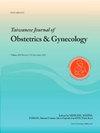扩大无创产前检测在与 46,XX,der(1)t(1;2) (p36.2;q37.3)dmat 家族性不平衡互变相关的胎儿 1p36 缺失综合征遗传学研究中的首胎应用
IF 2
4区 医学
Q2 OBSTETRICS & GYNECOLOGY
引用次数: 0
摘要
目的我们介绍了扩增无创产前检测(NIPT)在胎儿 1p36 缺失综合征(与 46,XX,der(1)t(1;2)(p36.病例报告 一位 37 岁的高龄产妇在妊娠 13 周时接受了扩大的 NIPT 检查。她曾有过一次自然流产的经历。由于输卵管闭塞,她通过体外受精和胚胎移植(IVF-ET)怀孕。NIPT 检测结果呈 1p36 缺失阳性。妊娠 17 周时,她接受了羊膜腔穿刺术,但羊膜腔穿刺术后发生胎儿宫内死亡,妊娠终止。羊膜腔穿刺术发现了 1 号染色体的衍生染色体,1 号染色体的短臂末段异常。随后对父母血液进行的细胞遗传学分析显示,父亲的核型为 46,XY,母亲的核型为 46,XX,t(1;2)(p36.2;q37.3)。羊膜细胞的核型为46,XX,der(1)t(1;2) (p36.2;q37.3)dmat,符合部分单体1p(1p36.2→pter)和部分三体2q(2q37.3→qter)。对从培养羊膜细胞中提取的 DNA 进行的阵列比较基因组杂交(aCGH)分析显示,1p36.33-p36.22(852,863-11,303,452)×1.0 阵列和 2q37.3(242,785,405-243,068,396)×3.0 阵列[GRCh 37]结果显示,1p36.33-p36.22 的缺失为 10.451-Mb 。33-p36.22 包含 116 个 OMIM 基因(包括 RERE),2q37.3 的 283-kb 重复包含一个 OMIM 基因 PDCD1。本文章由计算机程序翻译,如有差异,请以英文原文为准。
First-trimester application of expanded non-invasive prenatal testing in the genetic investigation of fetal 1p36 deletion syndrome associated with a familial unbalanced reciprocal translocation of 46,XX,der(1)t(1;2) (p36.2;q37.3)dmat
Objective
We present first-trimester application of expanded non-invasive prenatal testing (NIPT) in the genetic investigation of fetal 1p36 deletion syndrome associated with a familial unbalanced reciprocal translocation of 46,XX,der(1)t(1;2) (p36.2;q37.3)dmat.
Case report
A 37-year-old, gravida 2, para 0, woman underwent expanded NIPT at 13 weeks of gestation because of advanced maternal age and the fear of complications of invasive procedures of prenatal diagnosis. She had experienced one spontaneous abortion. The pregnancy was conceived by in vitro fertilization and embryo transfer (IVF-ET) because of tubal occlusion. NIPT was positive for 1p36 deletion. At 17 weeks of gestation, she underwent amniocentesis but intrauterine fetal death occurred after amniocentesis and the pregnancy was terminated. Amniocentesis revealed a derivative chromosome 1 with an aberrant short arm terminal segment of chromosome 1. Subsequent cytogenetic analysis of parental bloods showed a karyotype of 46,XY in the father and a karyotype of 46,XX,t(1;2) (p36.2;q37.3) in the mother. The karyotype of amniocytes was 46,XX,der(1)t(1;2) (p36.2;q37.3)dmat, consistent with partial monosomy 1p (1p36.2→pter) and partial trisomy 2q (2q37.3→qter). Array comparative genomic hybridization (aCGH) analysis on the DNA extracted from cultured amniocytes revealed the result of arr 1p36.33p36.22 (852,863–11,303,452) × 1.0 and arr 2q37.3 (242,785,405–243,068,396) × 3.0 [GRCh 37] with a 10.451-Mb deletion of 1p36.33-p36.22 encompassing 116 OMIM genes including RERE and a 283-kb duplication of 2q37.3 encompassing one OMIM gene of PDCD1.
Conclusion
Expanded NIPT has the advantage of early detection of familial unbalanced reciprocal translocation in the fetus.
求助全文
通过发布文献求助,成功后即可免费获取论文全文。
去求助
来源期刊

Taiwanese Journal of Obstetrics & Gynecology
OBSTETRICS & GYNECOLOGY-
CiteScore
3.60
自引率
23.80%
发文量
207
审稿时长
4-8 weeks
期刊介绍:
Taiwanese Journal of Obstetrics and Gynecology is a peer-reviewed journal and open access publishing editorials, reviews, original articles, short communications, case reports, research letters, correspondence and letters to the editor in the field of obstetrics and gynecology.
The aims of the journal are to:
1.Publish cutting-edge, innovative and topical research that addresses screening, diagnosis, management and care in women''s health
2.Deliver evidence-based information
3.Promote the sharing of clinical experience
4.Address women-related health promotion
The journal provides comprehensive coverage of topics in obstetrics & gynecology and women''s health including maternal-fetal medicine, reproductive endocrinology/infertility, and gynecologic oncology. Taiwan Association of Obstetrics and Gynecology.
 求助内容:
求助内容: 应助结果提醒方式:
应助结果提醒方式:


